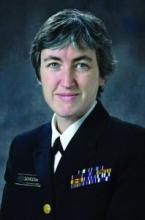SEATTLE – A total of 57% of girls and 35% of boys aged 13-17 years has received at least one dose of human papillomavirus vaccine as of 2013, according to national estimates released by the Centers for Disease Control and Prevention.
That’s an increase from 2012 data that found only 54% of girls and 21% of boys in that age group had received at least one dose of the vaccine.
The reason for the uptick is that clinicians are increasingly recommending vaccination against human papillomavirus (HPV). In 2013, 64% of girls’ parents and 42% of boys’ parents reported a provider recommendation for the vaccine, up from 61% and 28%, respectively, in 2012. The data were published July 25 in the Morbidity and Mortality Weekly Report (2014;63:620-4).
Even so, "it is concerning that approximately one-third of parents of girls and more than half of parents of boys reported that their child’s clinician had not recommended that their child receive an HPV vaccination. The lack of a clinician recommendation among parents of boys might reflect knowledge limitations among clinicians, because the recommendation for routine HPV vaccination for boys has been in place only since December 2011," wrote the investigators, led by Shannon Stokley of the Immunization Services Division at the CDC’s National Center for Immunization and Respiratory Diseases.
To increase uptake, the agency asked clinicians to recommend the vaccine when kids come in for other shots, such as tetanus, diphtheria, and pertussis (Tdap). If HPV shots were piggybacked onto those visits, CDC estimated that 91% of girls born in 2000 would have gotten at least one dose of the vaccine.
Meanwhile, about 86% of adolescents had received at least one Tdap shot in the 2013 survey. "The high coverage rate of Tdap vaccine shows us that it is certainly possible to reach our goal of vaccinating 80% of adolescents against cancers caused by HPV," NCIRD director Dr. Anne Schuchat said in a statement.
The findings come from a random-digit–dialed phone survey of the parents and guardians of 18,000 adolescents aged 13-17 years old; investigators checked medical records to verify what they were told.
Safety concerns also caused parents to shy away from the vaccine, but data do not bear out these concerns. "In the 8 years of post-licensure vaccine safety monitoring and evaluation conducted independently by federal agencies and vaccine manufacturers, and after 67 million doses of HPV vaccine have been distributed, no serious safety concerns have been linked" to the vaccine, the CDC noted.
As in 2012, about one-third of adolescent girls had all three doses recommend by the CDC’s Advisory Committee on Immunization Practices.
The agency has put together several resources to promote the vaccine, including an HPV website for clinicians, a tip sheet for talking to parents, and continuing medical education programs about the impact of persistent HPV infection.
The investigators are employees of the CDC.


